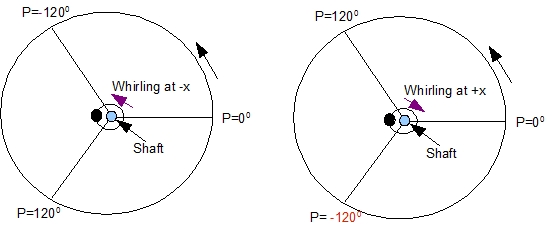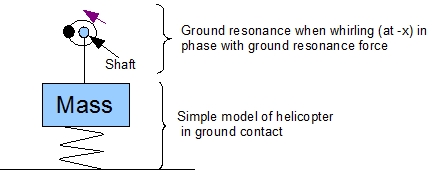Ground Resonance
When in contact with the ground (at touchdown), a helicopter with an articulated
rotorhead (more precisely, a rotorhead with drag hinges) can get into resonance
mode, which has the potential to destroy the aircraft. In this section, we look at what ground
resonance is, how it is generated and how to prevent it.
In a rotorsystem with drag hinges, the rotorblades can lead and lag in the plane
of rotation. It is then possible to achieve a situation whereby the blades are not
evenly
spaced around the circle of rotation, for example, due to a touchdown or another
external disturbance. In such circumstances, the centre of mass (CM) isn't aligned
with the mast (see figure), and will be rocked in all directions. Because a helicopter’s moment
of inertia is greater around the pitching axis than the
rolling axis, the pilot will probably experience lateral rocking.

In order to understand the exact nature of ground resonance, we will have to analyse it
in
more detail. This starts with the observation that each blade
resonates at a certain frequency in the plane of rotation (see also the last section
about Dragging Dynamics). We look at a blade in a rotating frame of reference, and assume that it resonates
at a particular frequency 'x'. Next, we will look at all of the blades together (in
example 3), as well as their phase relationship (figure below). Depending upon
the phase, there are a number of effects. The first is no effect on CM; the CM is
either whirling (=circular motion
of the rotorhub) at frequency '+x', whirling at '-x' (that is,
the CM travels the whirling circle in the opposite direction), or there is some lateral movement. The circumstances in which the whirling
adds to the rotor frequency (RRPM), is known as progressive whirling; when it is
negative, we call it regressive whirling.

We will now take the interaction between the hull and the rotorhub into account,
and will, therefore, return to a stationary frame of reference.
The hull experiences the rotor frequency and the whirling of the rotorhub. When
the rotor is turning with angular frequency 'X' (directly related to RRPM), we have
to include the whirling
frequency in order to get at the frequency experienced by the hull.
So, depending upon the type of whirling (progressive or regressive), this frequency
is 'X'+'x' or 'X'-'x'.
The hull also possesses some natural resonance frequency. When this meets
the rotor frequency, X, it will resonate. The movement of this resonant body is in an anti-phase
with the rotor frequency (by the physical nature of resonant systems). This
is still true at the frequencies 'X'+'x' or 'X'-'x' (because X >> x). Note that
the hull will only resonate when in contact with the ground. Otherwise, there
is no effective spring-mass system that can get into resonance. One should also realize
that the phenomenon we are studying, is an interaction between
a hull in resonance and the whirling rotorhub.

In this interaction, there is an important difference between the 2 situations,
with the whirling at either plus or minus 'x' (figure X). When whirling at +x, the hull's resonance force is in anti-phase with the whirling frequency. However, when the whirling happens at minus x, the hull’s resonant force is in phase with the
whirling frequency. Now, the hull’s resonance around rotor frequency X reinforces the hub's whirling.
This system isn't stable and will suffer from severe resonance.
Indeed, there is enough energy to completely disintegrate the hull, mast and
rotors. Clearly, this must be prevented.
The first and most common way to solve this problem is to use mechanical dampers,
which simply suppress any blade resonance in the plane of rotation. Dampers are
also used to dissipate kinethic energy on touchdown, preventing sudden disturbances
in the rotordisc, which could initiate ground resonance. These measures will effectively
prevent ground resonance. If it occurs despite these steps, (e.g. broken damper)
then the most effective way to stop it is to take off immediately. This is because
the hull will cease to resonate as soon as there is no ground contact.
If this is not possible, the only change to make is to reduce rotor speed (thereby changing the excitation frequency of the system).
Next topic > Control Power
|
Cyclic & Collective
- The title of this book leads me to wonder what more it will teach me in addition to its content about these two, most frequently used, helicopter input controls. As it turns out, the answer is: a lot more. Of course, all of the obligatory subjects like basic physics, rotor aerodynamics and helicopter performance are dealt with as well, as are piston engine and basic helicopter manoeuvres. Yet the scope of this book is actually much wider than one might initially think.
Firstly, it is divided into a 'beginners’ and an 'advanced’ section. This means that the book can treat more complex concepts in depth, even though the focus in the first section is directed more towards newcomers to the field.
Secondly, subjects like turbine engines, multi-engine helicopters and autopilots are also examined. This is particularly helpful, since these topics are not usually covered in the majority of helicopter books aimed at this target audience.
Thirdly, the book deals with many things that you will not normally find in a text book: helicopter related experiences and a great deal of interesting detail. This is the sort of information that can only be provided if you have flown a lot of different helicopters and have been working in this industry for some time. What’s more, this tone is amplified by the consistently narrative style of the book.
- 536 pages
|
|
Art of the Helicopter (Hardback)
- Well structured text that covers many technical aspects. It starts with an introduction to helicopters, followed by a treatment of
the technical background needed when studying them. Thereafter, dynamics, rotor systems, engines and transmission are explained in detail.
The book concludes with a section on performance and other types of rotorcraft. Its main asset is that the text is technically and
theoretically very accurate, and rather than mathematics, its focus is always on enabling the reader to achieve an understanding of
helicopters from a technical or engineering point of view. The more technically orientated reader will love this work.
- 416 pages
|
|
Principles of Helicopter Flight (Paperback)
- If you are wondering how a helicopter flies, and really want to comprehend the process, you have no choice but to delve into
aerodynamics. This means not only understanding which forces play a role and the laws of physics, but also being able to put it all
together and apply your knowledge to a rotating system consisting of a number of rotor blades. This is a demanding task and requires
some very hard work. It is, undoubtedly, worth the effort though, and will help you to become a better pilot. There are many books out
there to help you with this task of exploring the principles of helicopter flight, but they tend to fall into two camps:
populist and taking a rather simplistic approach, or highly technical and assuming the reader has a degree in mathematics.
This book is different, because it clearly explains the principles of flight in a step by step way that is easy for most
readers to follow. Further benefits are that a lot of attention is paid to flight manoeuvres and operations, and every chapter
concludes with questions as a study aid.
- 320 pages
|
Comments are disabled.